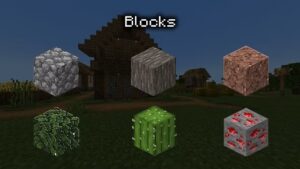Understanding Minecraft Blocks: Types, Uses, and Impact
Minecraft blocks are the heart and soul of the game, forming the foundation of every player’s creativity and exploration. From building grand structures to crafting intricate redstone contraptions, blocks provide endless opportunities to shape the virtual world. In this article, we’ll explore everything you need to know about Minecraft blocks, including their types, unique features, and how they impact gameplay.
Highlights of Minecraft Blocks
- Versatile Uses: Build, craft, and create with over 150 unique blocks.
- Endless Creativity: Design stunning structures and automate tasks with redstone.
- Community Influence: Blocks evolve through player feedback and updates.
What are Minecraft Blocks?
Minecraft blocks are the fundamental units that make up the game’s virtual world, serving as the building, crafting, and interactive elements of gameplay. Each block in Minecraft has unique properties, ranging from basic materials like dirt, stone, and wood to functional blocks like crafting tables and furnaces. Players can use blocks to construct structures, gather resources, create tools, and design complex mechanisms with redstone. With over 150 block types, including decorative, utility, and biome-specific blocks, Minecraft offers endless possibilities for creativity, exploration, and innovation. These versatile blocks are the cornerstone of what makes Minecraft an iconic sandbox game.
Types of Minecraft Blocks
– Building Blocks
- Description: Used for constructing structures and crafting tools.
- Examples:
- Wood Planks: Versatile and renewable for houses and furniture.
- Stone Bricks: Durable and aesthetic for castles or fortresses.
- Glass: Transparent for windows and decorative builds.
– Natural Blocks
- Description: Found naturally in the environment, forming the terrain.
- Examples:
- Grass Blocks: Common in most biomes and used for landscaping.
- Sand: Found in deserts and beaches, used to craft glass.
- Dirt: Essential for planting and farming.
– Utility Blocks
- Description: Provide functionality for crafting, storage, and other tasks.
- Examples:
- Crafting Table: Creates advanced tools and items.
- Furnace: Smelts ores and cooks food.
- Anvil: Repairs items and combines enchantments.
– Redstone Blocks
- Description: Enable automation and engineering through electrical-like systems.
- Examples:
- Redstone Dust: Transmits power for circuits.
- Pistons: Push and pull blocks for moving mechanisms.
- Observers: Detect changes in nearby blocks and emit signals.
– Ore Blocks
- Description: Contain valuable resources used in crafting and upgrades.
- Examples:
- Diamond Ore: Yields diamonds for high-tier tools and armor.
- Iron Ore: Smelted into ingots for crafting.
- Gold Ore: Used for tools, armor, and golden apples.
– Decorative Blocks
- Description: Enhance the visual appeal of builds.
- Examples:
- Glazed Terracotta: Colorful and patterned for artistic designs.
- Concrete: Smooth and vibrant, ideal for modern builds.
- Stained Glass: Adds color to windows and creative builds.
How to Use Minecraft Blocks
– Building Structures
- Purpose: Create homes, bridges, monuments, and cities.
- Steps:
- Collect building blocks like stone, wood, or bricks.
- Place blocks strategically to form walls, roofs, and floors.
- Use decorative blocks like stained glass or terracotta to enhance aesthetics.
- Tips:
- Combine different textures to add depth to builds.
- Use stairs and slabs for detailed designs.
– Crafting Tools and Items
- Purpose: Create tools, armor, and other useful items.
- Steps:
- Place a crafting table to unlock advanced crafting options.
- Combine resources like wood, stone, iron, or diamonds in the crafting grid.
- Craft utility items like furnaces, chests, and beds.
- Example:
- Combine planks and sticks to craft a pickaxe for mining.
– Farming and Agriculture
- Purpose: Grow crops, raise animals, and sustain survival.
- Steps:
- Till dirt or grass blocks using a hoe to create farmland.
- Plant seeds, saplings, or crops like wheat, carrots, and potatoes.
- Use water blocks and light sources to maximize growth.
- Tips:
- Surround farms with fences to protect crops from mobs.
– Exploration and Navigation
- Purpose: Aid in exploring the vast Minecraft world.
- Steps:
- Place blocks like torches to mark your path in caves or forests.
- Use dirt or cobblestone to create pillars for visibility.
- Carry beds to set respawn points while exploring far from home.
- Tips:
- Keep a stack of building blocks for bridging gaps or scaling cliffs.
– Defense and Combat
- Purpose: Protect against hostile mobs and other players.
- Steps:
- Build walls and fortifications using stone or obsidian.
- Place iron doors or trapdoors for secure entryways.
- Use blocks like magma or campfires for defensive traps.
- Example:
- Surround your base with fences and water moats to deter mobs.
– Storage and Organization
- Purpose: Manage resources and inventory efficiently.
- Steps:
- Craft chests to store items in your base.
- Use barrels for compact storage options.
- Organize resources into labeled categories using signs or item frames.
- Tips:
- Use shulker boxes for portable storage solutions.
Resource Blocks in Minecraft
Ore Blocks
– Common Ore Blocks:
- Coal Ore:
- Location: Found at all levels of the Overworld.
- Use: Smelt items and craft torches.
- Iron Ore:
- Location: Found in caves and underground layers.
- Use: Smelt into iron ingots for crafting tools, armor, and buckets.
- Gold Ore:
- Location: Found deep underground and in the Nether.
- Use: Craft golden apples, clocks, and powered rails.
- Diamond Ore:
- Location: Found deep underground (Y-levels 16 and below).
- Use: Craft high-tier tools, armor, and enchanting tables.
- Emerald Ore:
- Location: Exclusive to mountain biomes.
- Use: Used as currency for trading with villagers.
– Rare Ore Blocks:
- Redstone Ore:
- Location: Found below Y-level 16.
- Use: Power redstone circuits and create complex mechanisms.
- Lapis Lazuli Ore:
- Location: Found between Y-levels 0 and 30.
- Use: Used in enchanting and crafting dyes.
- Ancient Debris:
- Location: Found in the Nether below Y-level 15.
- Use: Smelt into Netherite scraps to craft Netherite tools and armor.
Block Forms of Resources
– Compressed Resource Blocks:
- Iron Block:
- Use: Compact storage of iron ingots; also used in crafting beacons.
- Gold Block:
- Use: Compact storage and crafting golden apples or beacons.
- Diamond Block:
- Use: Decorative and compact storage of diamonds.
- Emerald Block:
- Use: Store emeralds or use for beacons.
– Utility Resource Blocks:
- Coal Block:
- Use: Efficient fuel source in furnaces.
- Redstone Block:
- Use: Powers redstone circuits and machines.
- Lapis Block:
- Use: Compact storage or decorative purposes.
Creativity and Customization in Minecraft
– Building and Architecture
- Freedom of Design:
- Players can construct anything from small cottages to massive cities.
- The block-based nature of Minecraft allows for detailed and intricate designs.
- Variety of Blocks:
- Over 150 block types offer diverse textures, colors, and functionalities.
- Decorative blocks like glazed terracotta, stained glass, and concrete enable artistic builds.
- Inspiration:
- Replicate real-world architecture or create entirely unique designs.
– Redstone Mechanisms
- Automation:
- Create automated farms, item sorters, or mob traps using redstone.
- Complex Machines:
- Build elevators, doors, or even calculators with redstone circuits.
- Interactive Builds:
- Use levers, buttons, and pistons to add interactivity to your creations.
– Customizing Gameplay
- Game Rules:
- Modify difficulty levels, spawn rates, and survival mechanics.
- Command Blocks:
- Use commands to create unique mechanics, teleportation, or quests.
- Adventure Maps:
- Design story-driven maps with puzzles, dungeons, and challenges.
– Skins and Character Customization
- Custom Skins:
- Players can upload personalized skins or choose from thousands available online.
- Expression:
- Reflect your style, interests, or favorite characters through custom appearances.
– Inspiration and Community Projects
- Player Collaborations:
- Work with others on large-scale builds or server projects.
- Community Events:
- Participate in build challenges or competitions to showcase creativity.
- Shared Worlds:
- Explore and draw inspiration from builds shared online.
Block Categories in Minecraft Mods
Technology-Based Blocks
- Purpose: Enhance automation, energy production, and complex systems.
- Examples:
- Generators: Produce power for machines (e.g., coal generators in IndustrialCraft).
- Conveyors: Automate item transport (e.g., Immersive Engineering).
- Fabricators: Automate crafting processes.
- Popular Mods:
- Thermal Expansion
- Applied Energistics 2
Magic and Enchantment Blocks
- Purpose: Provide mystical gameplay elements such as spells, rituals, and magical items.
- Examples:
- Runestones: Activate rituals and spells (e.g., Thaumcraft).
- Mana Pools: Store energy for magical tools (e.g., Botania).
- Infusion Altars: Combine items to create powerful artifacts.
- Popular Mods:
- Botania
- Blood Magic
Farming and Food Blocks
- Purpose: Expand agriculture and cooking mechanics with new crops and edible items.
- Examples:
- Crop Sticks: Enhance crop growth (e.g., AgriCraft).
- Fruit Trees: Generate new food resources (e.g., Pam’s HarvestCraft).
- Beehives: Produce honey and wax (e.g., Forestry).
- Popular Mods:
- Pam’s HarvestCraft
- Forestry
Biome and World Expansion Blocks
- Purpose: Introduce new biomes, terrains, and environmental features.
- Examples:
- Bioluminescent Blocks: Emit light in exotic biomes (e.g., Biomes O’ Plenty).
- Crystal Blocks: Enhance visual aesthetics of new dimensions.
- Custom Trees and Flowers: Add diversity to landscapes.
- Popular Mods:
- Biomes O’ Plenty
- Twilight Forest
Utility and Functional Blocks
- Purpose: Simplify tasks or enhance game management.
- Examples:
- Chunk Loaders: Keep areas active while the player is away.
- Storage Drawers: Provide organized, compact storage solutions.
- Waypoint Markers: Allow teleportation between locations.
- Popular Mods:
- Iron Chests
- JourneyMap
Transportation Blocks
- Purpose: Enable efficient movement of players, items, and entities.
- Examples:
- Portal Blocks: Create interdimensional travel points (e.g., The Aether).
- Elevator Blocks: Vertical transportation (e.g., OpenBlocks).
- Rails and Tracks: Enhanced railway systems.
- Popular Mods:
- The Aether
- OpenBlocks
Decorative and Aesthetic Blocks
- Purpose: Add unique textures, colors, and designs for creative builds.
- Examples:
- Custom Furniture Blocks: Chairs, tables, and shelves.
- Patterned Bricks: Themed designs for fantasy or modern builds.
- Lighting Options: Enhanced light sources like chandeliers or lamps.
- Popular Mods:
- Chisel
- Decocraft
Combat and Defense Blocks
- Purpose: Aid in battles, base protection, and mob farming.
- Examples:
- Turrets: Automatically attack hostile mobs (e.g., Turret Mod Rebirth).
- Traps: Cause damage or immobilize enemies.
- Shield Generators: Create protective barriers around bases.
- Popular Mods:
- Turret Mod Rebirth
- SecurityCraft
Environmental and Weather Blocks
- Purpose: Introduce new weather effects and environmental mechanics.
- Examples:
- Weather Controllers: Change weather patterns (e.g., Draconic Evolution).
- Heat Blocks: Simulate temperature effects in gameplay.
- Corruption Blocks: Spread effects that change terrain over time.
- Popular Mods:
- Draconic Evolution
- Tinkers’ Construct
Dimension-Specific Blocks
- Purpose: Define the look and mechanics of new dimensions.
- Examples:
- Aether Blocks: Unique materials from the Aether dimension.
- Twilight Forest Blocks: Mysterious and magical blocks exclusive to the Twilight Forest.
- Void Blocks: Found in mysterious dimensions with unique gravity mechanics.
- Popular Mods:
- The Aether
- Twilight Forest
Conclusion
Minecraft blocks are the backbone of the game, offering endless possibilities for creativity, exploration, and innovation. Whether you’re a casual builder, a redstone engineer, or an adventurous miner, blocks allow you to shape your world in unique and exciting ways. With continuous updates and community-driven contributions, Minecraft blocks remain a key element of the game’s success, inspiring players worldwide to push the boundaries of their imagination.
Ready to dive into the limitless world of Minecraft blocks? Start building your masterpiece today and discover the endless potential they hold. Follow APKAFE for expert guides, updates, and creative tips to elevate your Minecraft experience. Take your first step—one block at a time—into a world of infinite possibilities!
User Reviews








